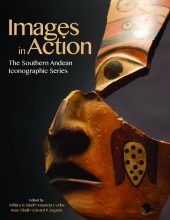15.51
These details from the left upper portion of the Ponce monolith are replete with Anadenanthera colubrina symbols, as is the entire statue and many other Tiahuanaco religious sculptures. It seems likely that relative abundance of Anadenanthera colubrina imagery in Tiahuanaco (and Huari) religious art relates to the popularity of hallucinogen-induced, shamanic types of religious experiences among the patrons of that art. Scarcity of Anadenanthera colubrina imagery in religious art probably relates to preferences for more sober and doctrinal kinds of religious experiences. To the degree that this is true, it seems that Tiahuanaco (and Huari) enjoyed two distinct modes of religious experience that were probably in conflict and negotiation, at least some of the time. Drawing by Amy Oakland, enlarged figures in red redrawn by William H. Isbell.
Item record
Image contents
Reuse
Isbell, William H.; Uribe, Mauricio I.; Tiballi, Anne; Edward P. Zegarra, 2018, "Visual database", https://doi.org/10.25346/S6/1B33FN.

